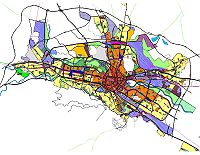
Photo from wikipedia
This study investigates the spatial effects of the service frequency and transport interchange facilities of rail stations on residential property values for the entire metropolitan train network in Melbourne. Residential… Click to show full abstract
This study investigates the spatial effects of the service frequency and transport interchange facilities of rail stations on residential property values for the entire metropolitan train network in Melbourne. Residential properties are classified as either detached or attached dwellings. Given that a traditional hedonic price model cannot handle the spatial dependence and spatial non-stationarity of the housing market, several geographically weighted regression (GWR) models are used and multicollinearity is considered; the model with the Euclidean distance metric outperforms others. Results indicate that the service frequency and facilities of the stations influence the residential property values in a spatially variable way. For every 1 km closer to the train stations, an increase in the frequency of the train services per unit results in a change in the residential property values ranging from −4.01% to 2.71%; an improvement in the transport interchange facilities per unit results in a change in the residential property values ranging from −29.93% to 47.04%. Crime and retail activities that indirectly affect the relationship between rail stations and residential property values are also identified. For every 1 km closer to the train stations, the crime density increases significantly from 5.64% to 42.88% and this occurs in one-fifth of the areas in Melbourne. In contrast, the relationship between retail activities and train stations remains spatially stable. This study complements the relatively scarce literature on the link between railway service levels and residential property values while extending the case study to the local level.
Journal Title: Urban Studies
Year Published: 2020
Link to full text (if available)
Share on Social Media: Sign Up to like & get
recommendations!